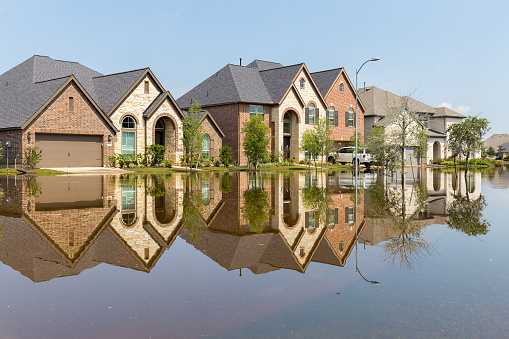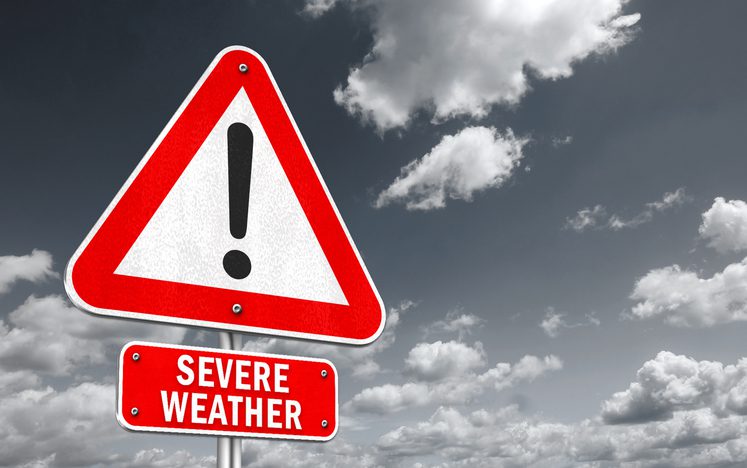Each year storm surges and the floods they cause pose significant risks to lives and property along the U.S. east coast and the Gulf of Mexico. A storm surge is the rise in sea level that can accompany a storm such as a hurricane. When a storm surge occurs in conjunction with a high tide, the effects can be especially damaging.
During hurricanes and tropical storms, fast-rising waters can do more damage to homes and other structures than powerful winds. Ocean waters rushing inland can inundate communities so quickly that there may be no time to evacuate.
“What can be dangerous about storm surge is it causes the sea level to rise above what people are used to,”says Robert Munroe, a meteorologist with the National Oceanic and Atmospheric Administration (NOAA). “People who live or vacation on the coast can be taken by surprise.”
According to the American Meteorological Society, 2,544 people died in the U.S. and its coastal waters from hurricanes between 1963 and 2012. Storm surge caused 49% of those deaths.
Cause of Storm Surge
Storm surge occurs during hurricanes and tropical storms.
- A tropical storm has sustained winds of at least 39 mph.
- The storm becomes a hurricane when the winds reach 74 mph.
These storms typically form over warm, tropical waters. Winds circulating around the eye of the storm produce vertical circulations of water. When a hurricane reaches shallow waters near a coastline, the circulation is disrupted and water is forced inland, creating a surge. In addition to destroying structures and causing drownings, a surge can disrupt communities by making highways impassible and knocking down power lines.
According to the National Hurricane Center, weather forecasters often can predict when and where hurricanes will make landfall only from a few days up to one week in advance.
Areas Most at Risk for Storm Surges
In 2015, catastrophe risk modeling firm Karen Clark & Co. issued a report on the eight U.S. cities most vulnerable to storm surges. The report is based on likely damage to residential, commercial, and industrial properties. Most were concentrated in the southeast, where tropical storms and hurricanes are common. Much of the population in the Atlantic and Gulf Coast states is clustered in areas that are less than 10 feet above sea level and highly susceptible to coastal flooding.
The U.S. Cities Most Vulnerable to Storm Surge
The study was based on the impact of a 100-year hurricane, a storm so large that the chances of one occurring are one in 100 in any given year.
1. Tampa, Florida.This community was judged to be at greatest risk. According to the report, 50% of the population lives on low elevations. During a tropical storm or hurricane, large buildups of water can become trapped in the city’s bay, causing flooding that inundates areas of Tampa and neighboring St. Petersburg.
2. New Orleans, Louisiana.Surges here are exacerbated by low elevations and a marshy terrain. These conditions enable flooding to travel many miles inland during a storm surge.
3. New York City, New York. The five boroughs of America’s most populous city have lengthy coastlines that expose them to flooding. The large number of properties built near the coast at low elevations makes this city highly susceptible to storm surge damage.
4. Fort Meyers, Florida. Most of the population lives in areas below 10 feet in elevation. The area has little natural protection from storm surges.
5. The Galveston-Houston, Texas area.Before Hurricane Harvey in 2016, Hurricane Ike in 2008 caused billions of dollars of flood damage in this low-elevation coastal community.
6. Sarasota, Florida. A densely populated coastline places this city in harm’s way.
7. Charleston, South Carolina. Charleston is located on an inlet near two rivers, exposing it to serious flood risk. Hurricane Hugo caused major storm surge flooding in Charleston and the adjacent islands in 1989.
5 Tips to Protect Yourself and Your Home Before the Storm
If you live in an area prone to storm surges, being prepared can save your life. Here are tips for getting organized for a severe storm:
1. Determine your risk. Start by knowing if your property is at risk of flooding. You can identify storm surge zones online at NOAA.
2. Purchase a flood insurance policy. If you want to protect your home from the flood damage associated with storm surges, you could be making a mistake by relying on standard homeowner’s insurance. That’s because such policies typically do not cover for property loss or damage due to flooding.
3. Organize your emergency supplies. Emergency preparedness requires a plan and the right supplies that can make it easier to grab-and-go if you’re told to evacuate.
4. Keep a portable radio handy. When a serious storm is coming, you should listen to the radio for weather news, in case you have to evacuate quickly. Because storms often result in power outages, it’s best to have a battery-operated radio.
5. Prepare your home for flooding. If you live in an area prone to flooding, you can reduce the risk of damage to your home by elevating utilities, such as electrical panels, switches, and appliances.
Next Steps: 4 Tips After the Storm
1. Obey evacuation orders. If an evacuation is ordered by public safety officials, it’s because you’re in danger. It’s not safe to remain in your home.
2. Don’t walk in moving water. To stay safe, avoid walking in moving flood waters if at all possible. It’s easy to fall and get swept away.
3. Don’t return home too soon. It can be dangerous to return to a home damaged by flooding before authorities say it’s safe. Make sure your home is structurally sound before you go back inside.
4. Document storm damage. When it is safe to do so, document flood damage in case you need to file a claim with your insurance company. The easiest way to do this is with a digital camera or your smartphone. If you end up filing an insurance claim, the photos will help you establish the seriousness of your loss.
Historical Storm Surges and Their Impacts
When a storm surge occurs, it often leaves behind billions of dollars in damage and many lost lives. Here are some examples of storm surges and their effects:
Hurricane Isabel (2003)
- Storm surges reached eight feet above normal tide levels
- Parts of Delaware, Maryland, Virginia, and Washington D.C. were impacted
- The cost of the destruction was placed at more than $5 billion.
- According to NOAA, 17 deaths were caused by the storm.
Hurricane Katrina (2005)
- One of the most devastating storms in U.S. history.
- As the most expensive hurricane, Katrina’s damage was estimated at $108 billion.
- Storm surges of 25 to 28 feet above normal tide levels were recorded in New Orleans and along the Mississippi coast.
- Storm surge was the main cause of fatalities during Katrina.
Hurricane Dennis (2005)
- Landed in Florida but extended to inland areas of the southeastern U.S.
- Flooding exceeded seven feet.
- Damage was estimated at $2.23 billion.
- The storm resulted in 42 deaths: 22 in Haiti, 16 in Cuba, three in the U.S., and one in Jamaica.
Hurricane Ike (2008)
- Storm surges between 15 and 20 feet above normal tide levels along the Bolivar Peninsula of Texas and in the Galveston Bay area.
- Property damage from Ike in U.S. coastal and inland areas was estimated at $24.9 billion.
- Twenty people were killed in Texas, Louisiana, and Arkansas. Another 34 were reported missing.
Hurricane Sandy (2012)
- Responsible for at least 147 deaths in the northeast U.S., Canada, and the Caribbean, according to the National Hurricane Center.
- Fatalities in the U.S. included 48 in New York, 12 in New Jersey, five in Connecticut, two in Pennsylvania, and five in other states.
- Storm surges occurring at high tide helped contribute to Sandy’s $62 billion in damages.
Consider Flood Insurance
Floods are the most common natural disaster in the U.S. According to FEMA, if the area where you live has a low or moderate flood risk, over the course of a 30-year mortgage, you’re five times more likely to have a flood than a fire in your home. It makes sense to know your risk, and then to take steps to protect your family and your property.
The Hartford offers National Flood Insurance Program coverage to AARP members. Get a quote today!







